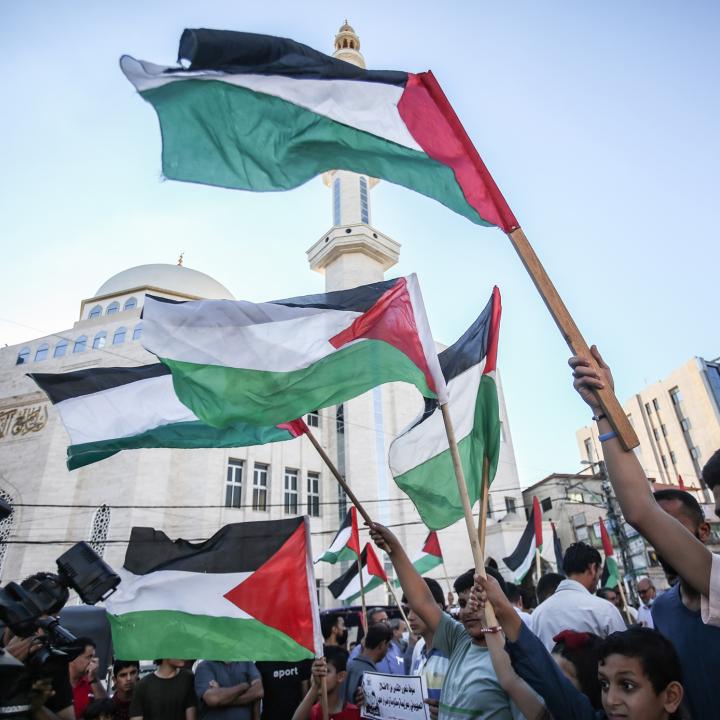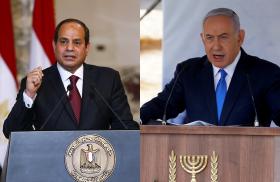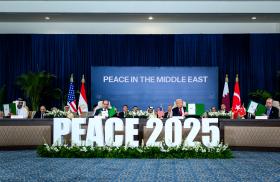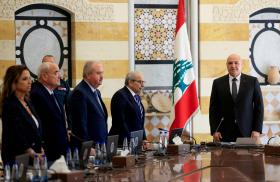
- Policy Analysis
- PolicyWatch 4121
The Ceasefire in Gaza: Views on Security, Palestinian Governance, and Regional Dynamics

A compilation of Washington Institute insights on the profoundly complex tasks ahead—from preventing a Hamas resurgence to promoting Palestinian political reform—and the states and mechanisms likely to carry them out.
Hamas, the Clans, and the Struggle for Control
Neomi Neumann
For Hamas, the ceasefire with Israel carries many risks, but it also opens a window of opportunity to reshape the reality on the ground in Gaza. From the moment it took effect on Friday, October 10,the group began redeploying its security apparatus, sending armed operatives back into the streets, and conducting a violent purge against its opponents, with a focus on Gaza clans suspected of collaborating with Israel during the war. Reports suggest that Hamas has already executed dozens of Gazans, and the group is circulating videos of public executions in order to reassert its dominance and instill fear in the population.
Clashes in the Tel al-Hawa neighborhood of Gaza City, where a Hamas force stormed a residential building held by the Dughmush clan, highlight the emerging power struggle. The anti-Hamas factions include about twelve clans with fewer than 1,500 armed fighters, compared to Hamas’s 15,000–20,000 armed operatives. While this gap reduces the likelihood of full-scale civil war, it increases the risk for assassinations that allow Hamas to consolidate its grip over the population. Of the clans, the largest and most established is Abu Shabab, whose members are concentrated in southeast Gaza near the Kerem Shalom crossing with Israel.
At present, the anti-Hamas clans lack the capability to withstand a direct offensive without external support, thus requiring Israel to act strategically to prevent a scenario of widespread violent retribution. Any future agreement should therefore include an explicit clause guaranteeing the security of the clans and potentially seek to gradually integrate their militias into Israel-controlled areas, with the longer-term goal of placing them under the Palestinian Authority. Such a move could help stabilize the territory, expand the operational space for non-Hamas actors, and thus prevent Hamas from reasserting full control over Gaza.
Principles for Supporting Palestinian Political Reform
Ghaith al-Omari
President Trump’s 20-point peace plan calls for the creation of a “technocratic, apolitical Palestinian committee” until “such time as the Palestinian Authority (PA) has completed its reform program.” This language creates both opportunities and risks for the future of Palestinian politics and governance.
On the plus side, the creation of a technocratic committee would likely be achievable given the abundance of Palestinian talent. But many “technocrats”—whether now or previously—have worked within the PA or the Gaza government, and separating them out from political operatives will be challenging. Excluding them wholesale—except for members of Hamas and other terrorist groups—will be a recipe for failure.
Of course, Hamas should play no role—either real or perceived—in creating the committee. Egypt is reportedly planning to convene a Palestinian national dialogue to address this issue. Furthermore, the United States must make clear to Arab states that Hamas’s disarmament and recognition of Israel are conditions for—not outcomes of—its participation in any process. If any such demands risk derailing the ceasefire, then the national dialogue should be deferred, with a priority placed on changing the balance of power in Palestinian politics.
A focus on revitalizing Palestinian politics will require seriousness regarding Hamas’s disarmament and regional efforts to discredit its narrative. But it will also require disciplined work to reform the PA, starting with a common understanding of what reform means. The U.S. administration, with its professed aversion to “nation building,” is unlikely to take the lead in implementing such reforms, but it needs to spell out organizing principles. Specifically, these principles should include effective and noncorrupt governance, combating of incitement in education and public messaging, and—most important—a political process that empowers new leadership untainted by terrorism or corruption. Clearly establishing these parameters will be essential for creating a common agenda upon which international and regional coalitions can base their efforts.
The Once and Future Roles of Qatar, Egypt—and Turkey
Ehud Yaari
Over the past two years, Qatar and Egypt acted as mediators between Israel and Hamas, although they did not fully coordinate their efforts and often engaged in quiet competition. For its part, Qatar sought a ceasefire that allowed for the release of the hostages in return for safeguarding Hamas’s survival and that of its remaining military force in Gaza. Egypt meanwhile was principally motivated by a desire to prevent conditions from deteriorating in a way that could prompt large numbers of Palestinians to storm the Egyptian border seeking refuge.
Whereas Qatar is a longtime sponsor of Hamas, having spent some $2–3 billion to support the group in Gaza while hosting its leadership in Doha, Egypt views Hamas in terms of its links to the Muslim Brotherhood, support for the late President Mohamed Morsi, and cooperation with the Islamic State in the Sinai Peninsula. Both governments were surprised by President Trump’s final outline for ending the war: Qatar felt it offered Hamas no role in Gaza, and Egypt was unhappy with the international mechanism proposed to run the territory, having advocated instead a Palestinian body established through agreement between the Palestine Liberation Organization, Hamas, and other factions. Yet neither government was inclined to challenge the U.S. initiative, given Qatar’s gratitude for Trump’s recent security guarantee and Egypt’s desire for generous American aid. Thus, the two countries, together with Turkey—which was enlisted by Trump—compelled Hamas to accept the first phase of the ceasefire plan, while promising help in discussions on the “day after” arrangement.
Yet the three actors are expected to pursue different courses with respect to Hamas’s future. Cairo wants the PA to reach accommodation with a disarmed Hamas, allowing President Mahmoud Abbas to assume a significant role in running the next Gaza administration. The two other mediators are keen to prevent the complete dismantling and disempowerment of Hamas’s military wing. In the event that Hamas commanders seek safe passage out of Gaza, both Qatar and Turkey would agree to admit them while Egypt would refuse. The United States will have to exercise its influence to guide these players toward effective cooperation.
Steps for Ensuring Security in Postwar Gaza
Dana Stroul
The 20-point Trump plan for Gaza includes a proposal for a multinational International Stabilization Force (ISF) to provide security on an interim basis until Palestinian forces can be trained and deployed. A major lesson from all postwar stabilization experiences is that filling the security vacuum in the immediate aftermath of war is the first task—and that providing “civilian-centric” security and restoring law and order are essential for preventing more violence.
Although several Arab and Muslim militaries have engaged in planning discussions with the United States for the past year on ISF modalities, no government is likely to make firm commitments to deploy forces absent assurances that their personnel will not come under attack from Hamas or Israel. Given its deep relationships with Israel and Arab partners, U.S. Central Command is well-positioned to lead operational deconfliction and oversight of the ceasefire, the ISF, and the Gaza stabilization mission. Indeed, CENTCOM announced last week that it would contribute to a joint task force with other international partners focused on hostage recovery in Gaza.
But the entire stabilization mission cannot be outsourced to CENTCOM: postwar governance, security, and assistance are inherently political, and the Trump administration will need to define the mission, clarify roles it is and is not willing to assume, and coordinate at a political level to keep the security mission on track. Egypt will be an important player given its shared border with Gaza and Israel. Qatar, Turkey, and Egypt together will be critical in sustaining pressure on Hamas remnants to avoid interference with the ISF—and to prioritize the needs of the Palestinian population in Gaza by compelling Hamas to turn over its weapons.
Training for vetted Palestinian forces will need to accelerate so that the ISF interim mission does not become a forever mission. The Office of the U.S. Security Coordinator (USSC), based in Israel, already developed plans for building a Palestinian security force focused on policing tasks for Gaza. Training should accelerate in Jordan at U.S.-supported facilities like the Jordan International Police Training Center, and the United States should prioritize coordination with Egypt to ensure that its training and vetting retains Israeli support.
How Turkey Will Seek to Benefit from Its Upgraded Diplomatic Role
Soner Cagaptay
President Recep Tayyip Erdogan has for the first time made Turkey a stakeholder in the Hamas-Israel conflict—and thus the future of Gaza. A longtime supporter of Hamas, Turkey now has a chance to shape the Israeli-Palestinian conflict by leveraging its influence over the group.
Another driver of Turkey’s interest in the conflict involves military ties with the United States. Since purchasing the Russian-made S-400 missile defense system in 2017, Ankara has been under U.S. military sanctions—but Washington now appears ready to lift these measures in return for confidence-building steps. One was Turkey’s key role in bringing Hamas to the negotiating table, a gesture that earned President Trump’s great appreciation. Despite wielding little influence over Hamas’s military wing, Ankara has cultivated close ties with the group’s political echelon, and Turkey’s intelligence chief, Ibrahim Kalin, specifically helped convince Hamas political leaders to agree to the current ceasefire deal.
The Gaza development has brought Turkey closer to acquiring U.S.-made F-35 fighter jets, with apparently growing support from Trump. But Ankara wants more than calm in Gaza; it also backs a two-state solution to the Israeli-Palestinian conflict, an outcome that enjoys little support from the current Israeli leadership and population alike. The ceasefire in Gaza along with a Turkish contribution to “day after” stabilization could assuage the highly tense Israel-Turkey competition, help calm Syria, and advance regional security—but a ceasefire breakdown could further worsen bilateral relations.
The Stakes for Hamas Disarmament
James Jeffrey
At the heart of President Trump’s 20-point Gaza peace plan, and of Israeli demands, is Hamas’s disarmament (i.e., “process of demilitarization”) and relinquishing of Gaza governance—paired with Israeli withdrawal and a broad international role in the postwar territory. If Hamas refuses these demands, the plan will fail, international ground engagement will collapse, and Israel likely will invade anew.
In the group’s October 9 statement, Hamas did not explicitly commit to disarmament, rather acknowledging “the conclusion of an agreement” that includes demilitarization, with the goals of “an end to the war” and “the occupation’s withdrawal.” (This refers not to the Trump plan but to a six-point Hamas-Israel agreement on the plan’s first phase.) But Hamas must know that those goals cannot be obtained without its disarmament “quid.”
The plan currently does not detail the disarmament who, when, how, or even what (e.g., infrastructure, tunnel demolition, ubiquitous small arms). An obvious candidate for independent demilitarization monitor would be the International Stabilization Force under the plan’s envisaged Board of Peace. It would be supervised by the recently announced CENTCOM-led international joint control center, possibly along with the international task force established in the Hamas-Israel agreement—but clarity has not yet emerged on specific roles.
Disarmament monitoring by international actors has been achieved before, and the ISF can develop the “how.” Ultimately, however, the conflict party—Hamas—must actually disarm, given that the ISF presumably will not fight the group. The real pressure on Hamas absent disarmament is thus renewed war under far worse circumstances, and the approbation of friendly regional “guarantor” states.







